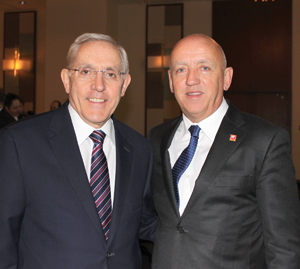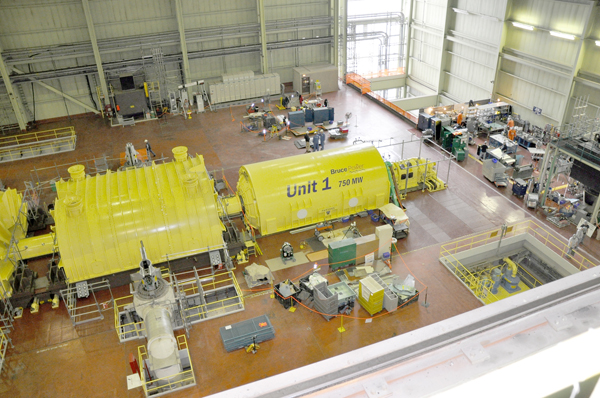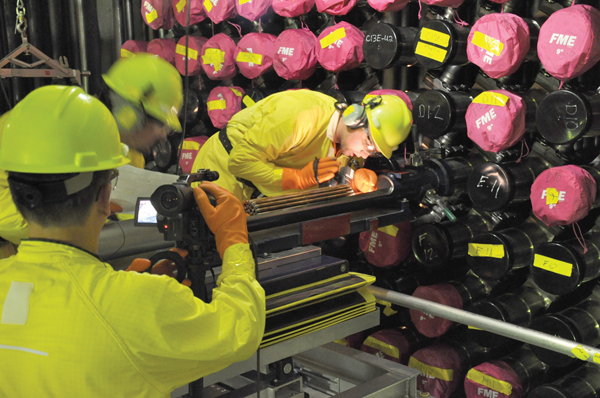Bruce Power CEO Duncan Hawthorne delivered a major speech to the Toronto Board of Trade on March 7, sharing his sense of accomplishment in returning the Bruce station to full operational capability, and his view of nuclear energy’s role on the world stage. Interest in his talk was so high that the venue had to be moved from the Board of Trade’s conference room to a larger one at a nearby hotel.

In general, the story of the revitalization at Bruce is well known. With eight units generating 6300 megawatts, Bruce Power is now the largest operating nuclear generating facility in the world. With an expected output of 50 TWh this year, “at a price that will be difficult to match,” Hawthorne said, it will provide Ontario with a third of its electricity. Bruce Unit 6 was rated the best in the world last year. Unit 4 ran for 594 days uninterrupted, an operational record. The refurbishment of Bruce A has been one of the largest examples of public-private partnership in history.
Hawthorne sees an undiminished future for nuclear power in the world. Even post-Fukushima Japan is building three new reactors, and will restart the currently idle ones, after some regulatory changes, he said. New reactors are under construction around the world, and Canada has a significant role to play. “Facts are our friend” he said, in reference to the nuclear industry.
In his wide-ranging discussion, Hawthorne suggested the timing may not be right for building new nuclear plants. “Ontario is not ready to go ahead yet with building new nuclear plants, of any type,” he said. “There’s a lot of questions about generation three plants. None have yet produced a megawatt of power. There’s not one such project around the world that’s on time and budget. There are pros and cons with all designs. Candu reactors can run while refueling, but they’re more complex to build and operate. Let someone else take that first-of-a-kind risk, and let it build a commercial case for itself. We did that for the refurbishment of Bruce 1 and 2 because we had to. Now we don’t have to. We can benefit from someone else’s experience. Right now our focus has to be on refurbishing what we have. Ontario’s next job is to manage a massive refurbishment of its nuclear fleet, a $20 billion job, between about 2016 and 2032.
In fact, Canada should consider reprocessing nuclear fuel, he argued. Currently we extract just 5% of the energy value of the fuel, and then bury the rest as waste. A closed fuel cycle, like that in France, India or China, would make better use of this resource and create less waste, and in fact the Candu is the best technology for that. The UK is looking at Candus to use its large plutonium stockpile, built by reprocessing its waste, Hawthorne said, and we should consider the same. But he admitted it’s not a conversation we’re ready for yet.
Hawthorne expressed particular satisfaction in having reversed a trend towards aging in the station’s workforce. When he took on the job at Bruce, the station had 2800 employees, of whom only 35 were under the age of 35, a consequence of laying off the junior employees first as they had only 4 reactors running at the time. Now Bruce Power has 4300 employees, 2800 of them new. More will be available thanks to partnerships with universities and colleges.
Hawthorne is largely untroubled by the frequent surplus generation arising from Ontario’s extensive dependence on nuclear power. “We tend not to know where power comes from, until we flick a switch and it isn’t there,” he said. “Having a surplus isn’t necessarily a bad thing. Ontario is unique, in having both a winter and a summer peak. This makes it a tremendous challenge to manage for. If you’re going to staff and supply to meet the peaks, you will always have surplus situations. And that’s okay. The important thing about reliable supply is you have it when you need it.”
“Love us or hate us, you need us,” he concluded.



